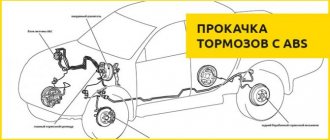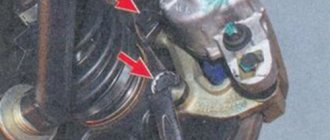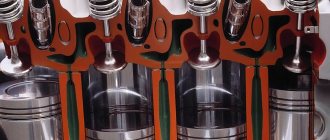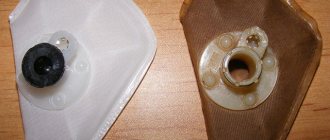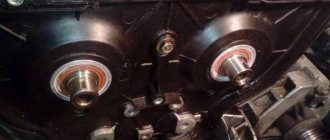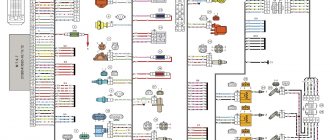History of Lada Priora
Historically, Lada Priora is the last family of cars to come out of the design workshops of the Togliatti automobile plant.
Along with the Lada Kalina, this car is one of the options for Zhiguli lovers and their descendants who want to drive everything new. Lada Priora's roots grow in the tenth version of Lada. It is made on the basis of ten, and the manufacturer does not hide this. Of course, the Priora has redesigned a lot, both externally and internally, which is easy to see by comparing the repair and operating manuals for these two cars. The Priora has a changed external and internal design, and the wheels are now driven by a 1.6-liter engine (81 horsepower or 98).
Everyone also admits that the design of the body has now made the Lada much safer, although on a global scale safety is average. In the basic configuration there is one airbag and that’s it (I believe that the body mentioned above can be ignored - it is common to all versions of the configuration). The most expensive version has two airbags (the second is also frontal, for the passenger), and also has pre-tensioning belts, its own parking sensors and ABS. By the way, the ABS of the Lada Priora is not natively made, but is supplied in Togliatti by Bosch.
Lada Priora began to be produced in 2007, in very small quantities. Then it was only a sedan. Currently, this car is also available as a station wagon and hatchback. It is interesting that AvtoVAZ does not want to stop there, and if the plant does not go bankrupt completely, then we will see Priora in coupe bodies, and, who knows, maybe even a convertible.
In the future, the release of this car with a 1.8-liter engine is also being considered. There are rumors about what else the inventive VAZ drivers can bring their youngest... Much has already been said about the automatic transmission, and AvtoVAZ promises to install it in its various cars for several years in a row. The plant, perhaps wisely, refused to develop its own box; it will be assembled by a third-party company from foreign components.
AvtoVAZ has not escaped the general GLONASS craze, since it has been announced that Priors will soon have a standard navigator, and of course, it will use a domestic navigation system. Finally, the designers are considering using an engine that will consume not only gasoline, but also natural gas. And finally, a few words about plans to strengthen security. The most expensive version of the Lada Priora will have as many as four airbags - two side ones will appear.
Generally speaking, for the money, the Lada Priora looks good, since in the configurations that the plant is promoting for the luxury version, other foreign classmates are much more expensive. The question about the reliability of all this is terribly awkward, so I really want to omit it.
Catalog of spare parts for VAZ Lada Priora
Wiring diagrams of VAZ Lada Priora
Labor intensity of work on VAZ Lada Priora
Manual for repair and operation of VAZ Lada Priora
2016-08-08 Lada Priora: the history of the emergence of a popular car in Russia
Lada Priora car rolled off the assembly line in the first month of spring 2007. It was a sedan, similar in appearance to the distant predecessor of the VAZ-2110. The design of the new car contained 950 radical changes. Two thousand new spare parts were installed on Priora. Thus, the released Lada was a completely new AvtoVAZ model. During the creation of the Priora, design errors that arose during the development of cars of the “tenth” family were corrected.
The appearance of the car has become more beautiful and proportional. Modern and better technologies for assembling components and assemblies have contributed to a significant reduction in the gaps between body elements. The machine's protection against rust has been enhanced. After the sedan, a hatchback went on sale, and 2 years later a station wagon appeared. Lada coupes are produced in small quantities. Cars belonging to the Priora family are equipped with a 1.6-liter sixteen-valve engine. At first, the car was equipped with a five-speed manual transmission. However, since 2014, cars with automatic transmission began to be produced. Drive the car to the front wheels.
Priora configurations
In the standard version of the new Lada, attention is drawn to the interior, which looks much richer and better than in the previous model. The new design was developed together with Italian painting professionals from the Carcerano studio. The new interior has a soft plastic “dashboard” panel and an instrument panel with an on-board computer. On the center console of the car, decorated with a silver trim, there is an oval-shaped clock. The car uses the best quality interior, there is a multiplex control system for electric mirror drives, fuel combustion activators. The use of improved insulation against noise, inserts for absorbing energy on the front doors, and “dashboards” made it possible to create a new level of comfort. The maximum configuration also includes a parking radar, air conditioning, alarm system, heated seats and other features. The vehicle underwent modernization in 2013. As a result, the level of equipment of the machine has improved.
In the basic configuration of the Priora sedan, a VAZ 21114 1.6 engine with eight valves is installed. Its power is 81 horsepower. This engine is a modification of the 2111 engine, in which the engine volume was increased to one and a half liters. Particular attention should be paid to a significant change in this engine, called VAZ-21126. There are two varieties of this engine: eight and sixteen valves. The sixteen-valve engine, whose power is 98 horsepower, allows the Lada to accelerate to the highest speed - 183 kilometers per hour. And the car can accelerate to 100 kilometers per hour in 11.5 seconds. Having driven 100 kilometers, Priora will consume 7.2 liters of fuel. You should pay attention to other transformations and improvements in comparison with the previous family. The car now has a reinforced clutch to increase the efficiency of the vehicle, a device to reduce the pressure of the driver’s foot on the brake pedal with a large diameter, and gearbox drive devices with closed bearings. Production of cars with an eight-valve engine was stopped in 2013. The sixteen-valve engine became the basis for the development of the modern VAZ-21127 engine, whose intake geometry changes. The new engine accommodates 106 “horses”. A year later, separate cars began to be produced, on which a powerful 1.8 engine (123 horsepower) was installed.
The new struts installed on the Priora at the front and rear of the car, the selected parameters of the shock absorbers and stabilizer struts, and the selected wheels of 185/65 14 radius were able to create all the conditions to achieve excellent performance in driving the vehicle. At the end of May 2009, Lada began to be produced in the body that is favorite for many car owners. In the station wagon, the roof panel was changed, the shape of the car's front buffer, glass, doors, lights and rear wings was changed. The Priora station wagon can be safely used for transporting various cargoes. The trunk holds 450 liters. The seats at the rear of the car can be quickly folded down to increase the luggage compartment by another 327 litres.
Equipment
The new Lada is very different from its predecessor in terms of reliability. Every year the level of equipment in the car increased. Now the “Norma” version has an airbag for the driver, seat belt pretensioners for the driver and front passenger, an ABS system, and a parking radar. Priora “Lux” is equipped with 4 airbags, has ABS and ESP systems, a precipitation control sensor, and an additional braking distance reduction system (BAS).
Although old developments and technologies were used in the development of Lada Priora , the car is still in great demand among Russian residents. The car often became a bestseller on the Russian market. The reason for such popularity of the Priora is the optimal ratio of good equipment and low cost.
History of Lada Priora, photo video, characteristics of Lada Priora
Putting a car into mass production and immediately starting to modernize it is our way. At least this is what happened with the VAZ-2110. In the late 90s, when the car just started rolling off the assembly line, it seemed like a novelty only to unspoiled buyers. The factory workers themselves understood perfectly well that the “ten”, work on which began back in the 80s, would very soon require at least a cosmetic update.
Based on world experience, AvtoVAZ relied on modernizing the appearance. The designers were given a difficult task - to get rid of the inherent heaviness of the VAZ-2110 with little effort. But the usual replacement of bumpers and linings in such cases was too little. “Pregnant antelope,” which is how evil tongues nicknamed the VAZ-2110, required much more serious intervention. The designers had to work on the optics, revise the rear arches, and change the shape and design of the rear bumper.
How difficult and painstaking the work was is evidenced by the fact that on the way to the appearance of the serial Priora, AvtoVAZ made five trial versions. The situation was complicated by the fact that the stamps of the doors, sides and roof had to remain unchanged in any case. Fortunately, by 2001, the final appearance of the new Lada Priora model was found and approved. By this time, it became clear to absolutely everyone that the “ten” could not do without a serious restyling.
The interior of the car had to be worked on just as much. Restrained by strict technological limitations, VAZ designers prepared a quite interesting version, which later received the name Status, but things did not go further than pre-production samples. Then AvtoVAZ decided to use the help of foreign specialists.
New Lada: Defects of engine parts. VAZ 2170 (Lada Priora)
The order to develop the interior for the future Priora went to the Italian company Carcerano Creative Engineering, which, although it coped with the work, had some reservations. At first, VAZ specialists had to often fly to Italy and adjust the European creation to the capabilities of the domestic industry.
Despite the fact that the Italians limited themselves to milling a soft cube and creating corresponding mathematical models, the interior turned out to be quite good, and for domestic cars of the mid-90s, absolutely excellent. Although now, many years later, I can’t shake the feeling that VAZ’s specialists could easily do without outside help. They had plenty of experience in interior design, accumulated over the years of AvtoVAZ's existence.
There were also changes invisible to the naked eye. In the process of transforming the “ten” into Priora, new equipment was purchased, thanks to which stamping and welding of body panels became more technologically advanced. Most innovations did not want to fit in with old solutions and required more and more changes. As a result, the Lada Priora, despite its similarity in appearance, does not have many common parts with the VAZ-2110.
Review of the Lada Priora model
History of creation
The Lada Priora car begins its history on April 21, 2007, when the first sales of the model began. In showrooms you could see sedans, only a year later hatchbacks appeared, station wagons came out another year later. The series included a coupe, but it was produced in limited quantities. The predecessor of this model, Lada “110”, was no longer produced in 2009. It was difficult to compete with a more comfortable and attractive car.
Equipment, exterior, interior
Although the Priora is a domestic development, a team of designers from the Italian studio Carcerano worked on the interior of the cabin. Depending on the configuration, the buyer receives: airbags, power windows for the front doors, air conditioning, sound insulation, a good audio system and much more.
Vehicle characteristics:
- Width: 1690 mm;
- Height: 1420 mm;
- Ground clearance: 165 mm;
- Maasa: 1670 kg;
- Tank volume: 43 liters.
It is worth noting that, compared to the previous model, anti-corrosion protection has been significantly improved; the manufacturer provides a 6-year warranty. Despite the fact that the Lada Priora is a restyled model, the differences from the “tenth” model are significant.
Power unit
The car is equipped with four-cylinder engines, 8-valve 1.6, 90 hp. on the VAZ-21116 model and 16-valve with a capacity of 98 hp. on the VAZ-21126 model. The chassis has modernized front suspension struts with barrel springs. The suspension has improved damping with the road. In the previous model, only a rear anti-roll bar was used; the Priora also features a front one.
Improvements in this model are also due to the fact that a large number of foreign-made components were used. In particular, the timing belt, the service life of which is 200 thousand kilometers, as stated by the manufacturer. The brakes were left unchanged; AvtoVAZ employees considered drum brakes to be the most effective.
Interesting Facts
The name “Priora” has no translation; this means that the car is a priority among the rest of the lineup. The first models used standard door handles that needed to be lifted, only in 2008 did “pull” handles appear. Since the launch of the model, almost a million cars have already been produced, while in 2009 and 2020 Lada Priora was the sales leader among domestic cars.
The car belongs to the budget class of Russian cars. There is a VAZ-21708, the body of which is 175 mm longer, production is carried out in limited quantities and it is not AvtoVAZ itself that does this, but its partner, it is noteworthy that the engine is installed with a power of 120 hp. volume 1.8 liters.
Conclusion
Lada Priora has been firmly on the list of the most desirable cars among the AvtoVAZ line for several years now. The car meets all the owner’s requirements and is the pride of the domestic automobile industry.
Market bestsellers. Lada Priora: at the end of history
Ten years ago - in March 2007 - AvtoVAZ started production of the Lada Priora passenger model, the successor to the history of the "ten". First of all, a sedan appeared, then a hatchback and a station wagon. The family had the honor of testing out some new technical solutions for the brand and entering the top of the national popularity ratings. But since 2015, degradation began: today the line has been reduced to the original sedan with a limited choice of versions, and next year, 2021, the production of this model will cease. It so happened that the development of production at AvtoVAZ was based on a completely different “seed” fund. Nevertheless, Lada Priora was and remains a noticeable phenomenon among Russian economy class cars.
Are the differences great?
If we recall the chronology of events, the Lada Priora family, even at the prototype stage in 2003, was promoted with the goal of correcting (or correcting) many of the shortcomings of the “tenth” family - from design to driving performance. According to the manufacturer, more than a thousand changes and improvements were implemented on the existing platform, and much more was done during the serial production process in subsequent years.
Pre-production Lada PrioraIn its main body, the Lada Priora sedan now occupies an intermediate position between the Lada Kalina/Granta and Lada Vesta. With a length of 4350 mm, a width of 1680 mm, a height of 1420 mm and a wheelbase of 2492 mm, the car belongs to the so-called B+ segment. The trunk with a capacity of 430 liters also fits within the class limits.
The outlines of the “ten” were visible mainly in the central part of the body, while the new wings, bumpers, hood, trunk, lighting, although they did not make the car completely different in appearance, did evolutionarily transform the appearance of the successor. Of course, it turned out ambiguous and not indisputable. To some, for example, the big-eyed cladding seemed inappropriately feminine and naive compared to the prickly narrow cut of the predecessor's headlights. But the main thing is that the light of the new headlights turned out to be effective. The front panel of the cabin has changed: instead of the “ten” underground, a more traditional structure for mass models has appeared. Despite its Italian origin (Carcerano studio), the panel was simple in appearance, but made using higher quality “grades” of plastic. True, this circumstance did not eliminate the problem of squeaks in the cabin, and the comfort of the “loose” seats did not add optimism to many owners.
Sales of LADA Priora
To begin with, some indicative figures from the biographical dossier. From 2009 to 2012, Lada Priora occupied exclusively the top positions in the sales list. The peak of fame came in 2011 - a record 138,697 copies were sold (according to AEB data), which ensured second place in the overall standings (the current leaders are oh so far from such indicators). In 2012, the model topped the list, but already with a result of about 126 thousand cars sold, and the next year there was an incredible retreat to eighth place with a result of just over 57 thousand cars sold throughout the country (a reduction of more than two times). Moreover, at this time there was a restyling and further modernization of the model. But this did not save it from inevitable collapse - ninth place in 2014, then 13th, and in 2016 - a complete rollback to 23rd place with a modest 17 thousand cars sold.
As one of the most popular Tolyatti models, Lada Priora has become a common (and even cult) object for various types of modifications and tuning. Ranging from typical design improvements (or fixes) in terms of ride quality, sound insulation, door seals, body corrosion protection and interior comfort, to major changes in engineering and styling (Stance and Rat Look). Many experiments border on vulgarity, but we must pay tribute - there are also very demonstrative projects with a large budget and high quality of execution
A certain step forward was made in terms of equipment, since initially all Priors were already equipped with at least a driver’s airbag as standard, and electric windows and mirrors, heated seats, air conditioning, armrests, remote control key or electric trunk lock were by no means exclusive to luxury versions. The conservative power steering was still present, but it began to be replaced by the fashionable electric power steering. At first, it did not work without whims, but then it gained the trust of the owners, who ultimately found it more convenient and less whimsical (no need to monitor, it does not leak, etc.).
Having started production of the Lada Priora in 2007 with a sedan (VAZ-2170), AvtoVAZ followed with a 5-door hatchback (VAZ-2172) with the same set of engines. And only in 2009 a station wagon (VAZ-2171) appeared with a number of original solutions. It was distinguished by an increased body height (1508 mm including roof rails), vertically shaped rear lights and rear side windows with “cut off” corners. The engine was initially offered only with a power of 98 hp, and with the 2013 restyling, a 106 hp version was added to it. In addition, in 2010, the family was expanded with a three-door hatchback, whose status was higher. The car was given the name Lada Priora Coupe: the body consisted of about 150 original parts, and the coupe was produced in a small series at the facilities of AvtoVAZ Pilot Industrial Production in the most expensive Luxe and Sport trim levels. In just 5 years of production, about 2,500 copies of Priora Coupe were assembledOn the engine side, a special feature was the use of only 1.6-liter engines, although at first the well-known fuel-injected 1.6-liter 8-valve engine with a power of 81 hp was offered in the basic version. with good throttle response: the maximum torque of 120 Nm was achieved at 2700 rpm. And yet, it was not he who determined the main power portrait of the car for many years of production.
The front part of the interior of the “first” Lada Priora is not without some zest - there is an analog clock on the center console and chrome inserts. The climate control unit with round knobs and an informative instrument panel is located at the bottom
Progress consisted of the appearance of a new VAZ-21126 engine with a power of 98 hp. (at 5600 rpm) and a peak torque of 145 Nm at 4000 rpm. Such an engine endowed the Priora with more lively dynamic qualities: acceleration to “hundreds” in 11.5 seconds, but most importantly, with an obvious reserve of power at high speeds. At the same time, under normal driving conditions, the engine had a small appetite: in highway modes, the actual consumption could not exceed five liters, in mixed modes - six to seven liters.
The hallmark of the Lada Priora family is the 16-valve 1.6-liter engine producing 98 hp. (VAZ-21126), with which an economy class car became dynamic and economical in a modern way. But the owners were faced with problems with the quality of components and some design flaws. Thus, the thermostat was capable of unexpectedly jamming, and in the closed position, oil could penetrate into the spark plug wells due to an unsuccessful seal of the cylinder head cover, and the heavily “sweating” upper hose of the crankcase ventilation system is an integral “stain” (albeit removable) almost all carsTrue, the overall picture of the “combat” power unit was spoiled by new operational realities. The two-shaft 16-valve cylinder head with a belt drive did not exclude premature breakage of the belt, for example, due to a jammed pump or tension roller, and such an event led to the meeting of the valves with the pistons and a rather expensive repair (25 thousand rubles or more). The belts themselves were not always able to “nurse” for the required period (at least 100 thousand km). The design of the timing belt includes hydraulic valve lash compensators, so there was no need to once again “climb” into the engine for adjustments. But the expansion joints themselves could become the reason for expensive repairs: it was possible that one or more could become stuck and require replacement, even with timely maintenance using high-quality oil.
The engine is not complicated by systems of variable valve timing or direct fuel injection, but even without that it cannot be called simple compared to its predecessors. First of all, on the electronic part: there are about a dozen sensors in the control system alone, as well as four individual ignition coils, electronic throttle control, and even such exotic things as the solenoid valve for purge the adsorber - a component necessary to meet increased environmental standards.
The sedan's trunk with a capacity of 430 liters is quite enough in most cases, even if it is somewhat squeezed by the wheel arches. There is a hatch for long items and a folding backrest. But there is also a structural problem - water getting into the side niches, presumably through ventilation windows and unsuccessful seals. I reacted simply - I made “drain” holes with plugs. Some car owners remove these plugs altogether - in this case, water penetrates from below, but the drainage is “automatic”In general, the Priora’s rich electronics were not without annoying “glitches,” and replacing some sensors with new ones did not always lead to a positive result the first time - the reason for this was defective spare parts. There are even cases of owners using “non-native” components, for example, when a capricious temperature sensor is replaced with a sensor from a Japanese car. In a number of cases, a malfunction “out of warranty” is eliminated at no small cost: for example, replacing a mass air flow sensor will cost around 4,000 rubles.
Taking into account the class, the Priora's interior is not distinguished by a generous supply of space, especially for tall people. However, before the modernization, complaints were limited to the comfort and durability of the seats, which was expressed not only in the use of covers, but also in the replacement of the driver's seat and even the rear sofa cushion
In addition, not everything turned out to be in order purely on the mechanical side. The fundamental design of the suspension remained the same, which was based on the “Soviet” development for the VAZ-2108. In front is a McPherson strut with shock-absorbing struts, forged wishbones, diagonal braces and a stabilizer bar attached to the arms through short “links.” The rear suspension is semi-independent, with a torsion beam. The main differences were different characteristics of shock absorbers and springs, as well as a stiffer anti-roll bar. All these alterations made the Priora chassis more compact, but with some damage to comfort. However, within the framework of individual operation, the owners could change the damping and other properties of the chassis in any way they wanted, for example, by selecting certain shock absorbers, springs, changing the stabilizer mounting pattern and similar tuning tricks.
Safety
In fact, Lada Priora entered the market in a “raw” form and was supposed to be improved during mass production, moreover, in the area of such an important component as passive safety. This is evidenced by an independent crash test conducted by Autoreview magazine using the EuroNCAP method - with a frontal impact at a speed of 64 km/h on a crushed barrier with an overlap of 40%.
According to the test results, sedans produced in 2007 could only qualify for two stars out of five: in terms of points scored (5.7 out of 16 possible), the Priora differed little from the VAZ-2110 (4 points) and Kalina (5.6 points). And only the “Lux” version with a reinforced body, two front airbags and seat belts with pretensioners showed higher protection for the driver and passenger - 10.56 points. At that time, this corresponded to three stars according to EuroNCAP and was approximately equal to the safety level of such foreign classmates as Renault Logan (12 points) or Chevrolet Lanos (10.5 points). In the first half of 2008, AvtoVAZ completed the modernization of the Priora body for all versions: with the introduction of more than 30 new reinforced elements (engine shield, A-pillars, roof, door bars, etc.), however, only one frontal one remained in the basic configuration airbag.
Restyling and lost opportunities
As mentioned above, various changes and improvements were made to the Priora’s design after the start of mass production, but the most noticeable transformation took place in 2013–14. The car received rear lights with LED sectors, an updated interior with a modified front panel and multimedia system, ESP, a VAZ-21127 engine with 106 hp, as well as a modified manual transmission with cable drive.
Restyling 2013. Changes in details have modernized the front panel, primarily due to a different design of the instrument panel and a different configuration of the center console, which is crowned with a larger multifunction display
Initially, the gearbox of the 2180 Priore series was inherited from previous generations of front-wheel drive VAZ models. That is, a unit with an outdated drive through rods with a lower location of the gear selection mechanism inside the housing. If the “howling”, vibrations and “looseness” of the lever were tolerated as inevitable, then oil leaks through the joint or oil seal of the rod “bothered” the owners of the first Priors quite a lot. Since 2012, the AvtoVAZ model range begins to try on the 2181 series gearbox - with a cable drive, a new gear selection mechanism, improved synchronizers and a number of other changes. Of course, Priora also got involved in this reform process; moreover, the model became the debut platform for the introduction of a functionally different transmission unit.
Today, AvtoVAZ’s experimental “bins” contain a copy of the Lada Priora station wagon with all-wheel drive and an inter-axle viscous coupling. Priora 4×4 could have taken on the mission of the first all-wheel drive station wagon from AvtoVAZ, but it remained a prototype.
In 2014, Lada Priora makes a small “robotic” revolution, becoming the first production model of the plant with an automated manual transmission of its own design (VAZ-2182). Before this, another model - Lada Granta - was already widely sold with a Japanese hydromechanical “automatic”, but for Priora they prepared something simpler, more accessible, economical and almost “our own”. Although, for reasons of prestige, the “robot” was installed only with the most powerful (and expensive) 106-horsepower engine.
The new unit was based on a modernized 5-speed gearbox with one clutch, which included an electronic control unit, a pair of electromechanical drives (gear selection mechanism and clutch) from the German company ZF and, of course, a different selector
In principle, the VAZ “robot” repeated the design of inexpensive foreign “colleagues”, previously known, for example, from Peugeot passenger cars. The main part of the box can be repaired like a regular “mechanics”, but the imported mechatronics are “declared” maintenance-free, its service life is declared (but not guaranteed) for ten years, and in case of failure, the entire unit is replaced. The VAZ “robot” was only 5 kg heavier compared to the original “mechanics”, did not require chassis reconfiguration and was easily adapted to other factory models. Actually, Priora remained in the role of a “launching pad”, since in the future, all the pleasures of the “robot” were mainly enjoyed by the buyers of Granta, Kalina and Vesta.
Options, prices
At the end of 2015, the Lada Priora line lost its hatchback and station wagon, and since 2016, the family has been offered in a greatly reduced and simplified form - options with an automated manual transmission have disappeared and the basic version with an 8-valve engine has returned. Today, the offer opens to a “forgotten” version with an 87 hp engine. in the Standard configuration - for 400,000 rubles. This price includes an airbag for the driver only, ABS, emergency brake assist, daytime running lights, electric power steering, trip computer, cabin air filter, front and rear armrests, height adjustment of the steering wheel and driver's seat, and electric front windows.
According to many, it was in the station wagon body that the Lada Priora acquired its most correct and harmonious forms. With a length of 4340 mm and a minimum trunk volume of 450 liters, the station wagon has become the most spacious and practical option in the line of budget cars for cargo and passenger transportation. If the car (or rather, its buyers) had been a little more lucky, then an all-wheel drive version would have gone into production!The remaining four versions are still equipped with a 106-horsepower engine and only a manual transmission. This is the Norma version (security alarm, engine protection, 14-inch wheels, remote key, electric and heated mirrors) - 440,600 rubles, the Norma Climate version (climate control, heated seats) - 481,000 rubles, as well as a couple of “image” » White Edition and Black Edition. In the latter case, the cars are equipped at the Norma Climate level with additional 15-inch alloy wheels and in the corresponding body color. Prices in both cases are 500,000 rubles.
Estimated cost of some standard spare parts and units for Lada Priora (in rubles)
| Engine VAZ-21126 (98 hp), without attachment/assembled | 60 000/87 000 |
| Cylinder head assembly (engine VAZ-21126) | 23 000 |
| Mass air flow sensor | 3400 |
| Speed sensor | 900 |
| Clutch assembly | 3200–4300 |
| Drive assembly | 3700–5100 |
| CV joint, outer | 1600–2250 |
| Front shock absorber strut | 2100–2600 |
| Upper rack support | 1200 |
| Front spring | 1100 |
| Rear shock absorber | 1300 |
| Headlight assembly | 4200 |
| Rear light assembly (sedan), before/after restyling | 1350/2350 |
| Front wing | 4300 |
| Rear wing (sedan) | 6700 |
| Hood | 9100 |
| Bumper, before/after restyling | 2300/4200 |
| Driver airbag | 4300 |
| Instrument panel (before restyling) | 4500 |
| Heater motor with fan | 1500 |
Lada Priora is a truly democratic car; you can meet people of all ages behind the wheel, which leaves its mark on the process of operation. All non-standard-looking Priors on Russian roads can be divided into two main categories. “Youth” ones are usually recognized by their lowered suspension (often adjustable using pneumatic elements), deep “all-round” tinting, spoilers, fashionable “casting”, etc. And “everyday” ones - with a practical approach of family and business owners: there are no unnecessary paraphernalia on the body, but there is always protection for the engine compartment and often a small and inexpensive body lift (due to spacers in the suspension) to increase geometric cross-country ability.
Owner reviews:
Lada Priora (hatchback, 2009, 98 hp, manual transmission) Lada Priora (hatchback, 2012, 98 hp, manual transmission) Lada Priora (hatchback, 2015, 106 hp, AMT ) Lada Priora (sedan, 2012, 98 hp, manual transmission) Lada Priora (sedan, 2015, 106 hp, AMT) Lada Priora (station wagon, 2009, 98 hp, manual transmission ) Lada Priora (station wagon, 2014, 98 hp, manual transmission)
Notes[ | ]
- ↑From G8 to Datsun in 30 years: platform of front-wheel drive VAZ cars
- ↑AVTOVAZ stopped production of Lada 111
- ↑ 12AvtoVAZ released the millionth Lada Priora - RealnoeVremya.com
- ↑Lada Priora will be discontinued in July (unspecified). Vedomosti (May 22, 2020).
- ↑The leader of North Korea arrived at the military unit in a Lada Priora. News. Channel One (Russian). Retrieved July 5, 2020.
- ↑ RESPECTED SUPREME LEADER COMRADE KIM JONG UN INSPECTED THE 1524TH ARMY UNIT OF THE KOREAN PEOPLE'S ARMY, DPRK Solidarity Group (July 1, 2020).
- ↑AvtoVAZ extended permission to produce Lada Priora
- ↑The Caucasus rejoices: production of the Lada Priora will continue
- ↑A photo of the latest Lada Priora body appeared on the Internet
- ↑The production of Priora station wagons will reach its design capacity by the end of June Archived on May 8, 2009.
- ↑Lada Priora station wagon goes on sale Archived May 8, 2009.
- ↑Birth of "Priors"
- ↑ 123Memories of the future. Archival copy dated July 15, 2021 on the Wayback Machine Nikita Rozanov, candidate of art history.
- ↑Second hands: Lada Priora
- ↑"Seven Versts": LADA Priora - scale of values
- ↑The most affordable Lada Priora went to the “series” - Kolesa.ru (Russian), KOLESA.ru - auto news, test drives, car catalog, reviews, dealers, communication (March 15, 2020). Retrieved November 3, 2021.
- ↑AVTOVAZ switched to the Euro-4 eco-standard – News – Official website of LADA (unspecified). www.lada.ru. Retrieved January 7, 2021.
- ↑Lada priora years of production. • Farewell, Lada Priora: history of the model towards the end of production (unspecified). globusks.ru. Retrieved January 7, 2021.
- ↑LADA Priora sedan – Technical characteristics – Official website of LADA (unspecified). Official website of LADA. Retrieved November 2, 2020.
- ↑ "Lada-Priora": little loss - website Behind the Wheel www.zr.ru. Retrieved November 2, 2021.
- ↑Lada Priora became the best-selling car in Russia in 2020. (undefined). Delovoe.tv (December 10, 2020). Retrieved January 14, 2021. Archived December 10, 2021.
- ↑The Russian car market grew by 39% (unspecified). Vedomosti (2020). Retrieved January 23, 2021.
- ↑AVTOVAZ summed up sales results for 2021 (unspecified). TLTnews.ru (2020). Retrieved January 14, 2021.
- ↑Statistics and ratings of car sales in Russia in 2020
- ↑best-selling domestic cars in Russia
- ↑ AvtoVAZ will release the 900,000th Lada Priora, Lenta.ru (May 26, 2020). Retrieved September 2, 2021.
Farewell, lada priora: history of the model towards the end of production
The last Lada Priora rolled off the assembly line in Tolyatti. The model was produced since 2007 and became a continuation of the “ten”, VAZ-2110. But the car's days are gone: it was AvtoVAZ's most archaic front-wheel drive car.
New Lada: Section 1. Design of the Lada Priora VAZ 2170 car
Work on the second-generation front-wheel drive car (counting from Samara) began in Tolyatti immediately after the VAZ-2108 entered the market. For a number of reasons, which are probably obvious to everyone, the process has been delayed. Pre-production “tens” were released in 1995, and mass production began in 1996.
The VAZ-2110 initially came out with an ambiguous design. Over the years, having become familiar on the streets, the car began to be perceived as quite decent. And at first, the nickname “pregnant antelope” was not the worst one invented by the people. Restyling of the model, as is customary all over the world, began to be prepared in advance. The motifs that were ultimately embodied in the production Priora could be seen already in the first prototypes. The VAZ-2110M2 (gray car in the photo) was not shown to the general public, but the 2110M4 (green car) was exhibited at the 2002 Moscow Motor Show.
If you look closely at the outlines of the Quartet, you will notice that the headlights on it are from a Chevrolet Niva (at that time still a former VAZ-2123). They were chosen, of course, for reasons of economy. The shape of the wings and hood was adjusted to fit the optics (they had to be reshaped in any case). But the appearance still turned out not to be the most harmonious.
Even in front, not to mention the stern, which remained overweight. At the rear, the ornament of the lanterns was only slightly changed and a molding was added. They didn't save the situation. It was obvious that we needed to think about deeper modernization. But the VAZ-2110M4 project still received a serial continuation. Under the designation 2110M, the updated “ten” went into production - with a different hood, bumpers and interior, but the same headlights.
In 2003, the next prototype of the Priora debuted. It didn’t yet have a name, only the index 2170. It differed from the car that ended up on the assembly line four years later only in minor nuances. They didn’t abandon the idea of using wide headlights and wisely ordered new optics. What is much more important, the design of the rear part of the body has been radically redesigned.
Although the sedan has similar outlines to the Opel Vectra B of the mid-1990s, the new style could not be compared with the original “ten”. It turned out nice. The station wagon that appeared in May 2009 looked even more interesting; it had a completely original rear end with high rear lights.
The future Priora also tried on several interiors. The top photo shows the front panel from the serial VAZ-2110M, a slightly improved version of the “tens” instrument panel. Installing it in a new model would require minimal investment, but would greatly reduce the effect of novelty. Therefore, after testing a number of solutions on prototypes, they finally ordered a completely new panel for Priora.
At that time, AvtoVAZ was producing Kalina with an already outdated “biodesign”, so the interior of the flagship sedan turned out to be modern and received definitely positive reviews. The interior changed again in 2021, when AvtoVAZ carried out a major modernization of the Priora. The most noticeable acquisition was the dashboard with a built-in multimedia system.
New Lada: Juicy new product: the history of the creation of Lada Kalina - KOLESA.ru - automobile magazine
The new model had about 1000 design differences from the VAZ-2110! In fact, it was a truly different car, despite the external similarity. In addition, AvtoVAZ seriously revised its approach to production culture and quality, which immediately put Priora on a different level.
It was produced not only in the form of a sedan, five-door hatchback and station wagon. The range included a three-door hatchback with the prefix “Coupe” and a small-scale extended version “Premier”. The lion's share of cars were produced with 1.6 engines. Eight-valve engines developed 82-87 hp, 16-valve engines developed 98-106 hp. in Togliatti they made small batches of Priora with a 123-horsepower 1.8 engine.
But in terms of gearboxes and options, the Lada Priora was a real flagship of the brand. In 2021, she was the first among VAZ cars to try on the AMT single-disc robot. It is still installed on the entire line of front-wheel drive vehicles developed in Tolyatti, including Vesta. For the first time for Lada, it was on the Priora that front and side airbags and air conditioning appeared in the basic configuration.
Except that the car didn’t have a standard audio system. It's only until 2021. But in general, the car had a very decent set of options: power accessories, heated seats, mirrors and windshield, navigation, parking sensors, ABS and ESP, pre-heater (installed for a short time), light and rain sensors.
Even before Vesta entered the market at the end of 2021, demand for the outdated Priora began to fall. It is difficult to play the role of a flagship when there is a cheaper, modern and spacious Granta, which is in no way inferior in terms of equipment and driving characteristics. As a result, the plant made the right decision to reduce the Prior range. Only a sedan with a limited range of trim levels and powertrains survived. They took it mainly in the southern regions of the country.
On July 11, the last body was welded in Togliatti, and on July 18, it turned into a finished car. The created warehouse stocks will last until winter, after which it will no longer be possible to buy a Priora with zero mileage. The era of the model, produced with a total circulation of about 1,000,000 copies, is over.
Source
People's love and popularity
Production of Lada Priora cars began in 2007, the model became a replacement for the “ten” - VAZ-2110, and turned out to be just as loved by the people as its predecessor. Numerous tuning companies offered countless modifications, turning the modest Priora into something like a racing car with gullwing doors. In recent years, car versions with pneumatic elements in the suspension have become popular, allowing the car body to be lowered onto the asphalt while parked.
In recent years, the plant itself has tried in every possible way to maintain interest in the model, releasing new configurations and adding new options. Some of the latest modifications are versions in white and black colors, which featured 15-inch wheels, two-tone seat upholstery, glossy interior inserts and other options.
Executive Vice President for Sales and Marketing of AvtoVAZ PJSC Jan Ptacek believes that the model no longer fits into the company’s current line of cars and creates an incorrect perception of the brand among buyers. And if previously such a car could be found in Lada showrooms, now buyers expect to see something different.
“For its time, the Lada Priora was a very good car that helped AvtoVAZ survive 10 years ago. Due to dramatic changes in the Lada brand over the past three years and the launch of a new generation of cars in 2015-2018. our consumers are changing their perception of the brand. And this, in turn, leads to a decrease in demand for Lada Priora. Thus, we made a logical decision to complete production of this model and concentrate on completely updating the LADA model range in the coming years,” said Ptacek.
That car did not gain much fame, even though it was piloted by the famous British racer, world touring stage winner James Thompson. Photo Morio / wikipedia.org
In total, more than 850 thousand cars have been produced since 2007. The most successful year was 2011, when 138 thousand cars were sold. For some time, the model was produced in the Chechen Republic at the Chechenavto enterprise.
The car also made its mark on the world racing scene. In 2009, the Lada Priora WTCC car debuted on the tracks of the World Touring Championship. However, that car did not gain much fame, even though it was piloted by the famous British racer, world touring stage winner James Thompson. Success for the AvtoVAZ racing team came later with Granta and especially with Vesta. Nevertheless, Priora laid the foundation and rightfully took its place in world racing history. By the way, you can see the racing modification of the car in the park complex of the history of technology named after. Sakharov in Tolyatti.
Specifications
Although the main thing, namely the platform, remained untouched. But it was also largely redesigned, thanks to which the new model partially got rid of the driving shortcomings characteristic of the “ten”. The steering has an electric booster, and the brakes have become lighter and more effective. The modernization also affected the 16-valve gasoline engine. A new crank mechanism and pistons with a shortened skirt made the 21126 engine not only quite powerful, but also economical.
Further more. AvtoVAZ decided not to ignore EuroNCAP requirements and equipped the Priora with seat belt pretensioners and an airbag. In addition, it was on the Priora that multiplex wiring appeared for the first time among VAZ models. And even though the Priore was still far from most foreign cars, the new model no longer had anything in common with the classic Lada.
Realizing that there would be more and more budget foreign cars every year, the factory workers began to equip their creation with air conditioning, heated seats, and an anti-lock braking system. And most importantly, most of the equipment installed on the car worked flawlessly. It is not surprising that the still affordable and at the same time relatively modern car easily found its buyers. In 2007, when production of the new product was finally launched, the plant easily reached a volume of 6 thousand copies per month.
Two years later, Priora completely ousted cars of the tenth family from the assembly line and is not going to give up its position yet. There is no need to talk about modern construction and, even more so, interesting design, but the price does its job. Lada Priora is still in service. How long?
